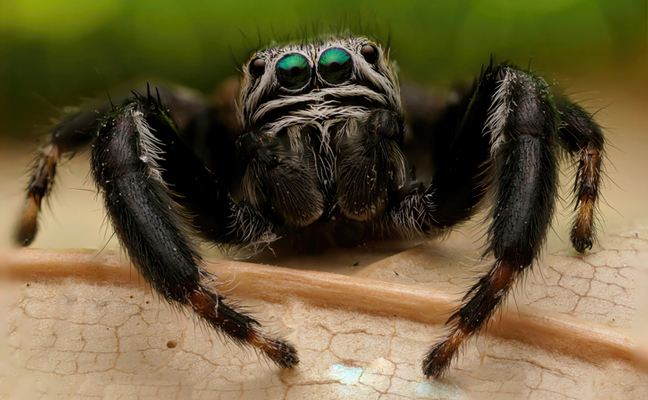
A male Evarcha arcuata, a jumping spider species. IMAGE: DAVID BIRKENFELD/iSTOCK/GETTY IMAGES PLUS/GETTY IMAGES
A new study suggests that spiders dream while they rest.
Daniela Rößler, an ecologist at the University of Konstanz, typically researches in the remote Brazilian Amazon, but coronavirus lockdowns in 2020 made her stick to research in a patch of grass near her home in Trier, Germany.
Rößler took to researching the tiny jumping spiders that lived in the field. After nightfall, some of the jumping spiders, about the size of her pinky fingernail, retired to little silken pouches called “retreats,” according to National Geographic. She found that some of the spiders would be immobile, dangling upside-down from a single strand of silk with legs curled and occasionally moving.
“The way they twitched just made me think of dogs and cats dreaming,” Rößler told National Geographic.
Rößler set up a nursery for baby spiders in her lab to observe their nightly dangles. Published Aug. 8 in Proceedings of the National Academy of Sciences, her new research shows a species of jumping spiders (Evarcha arcuata) experience a sleep-like state with rapid eye movement (REM) similar to those observed in dreaming humans.
REM sleep, which is characterized by muscle relaxation and changes in electrical activity in the brain, is thought to be important in memory consolidation and could play a role in developing survival skills. Confirming REM-like sleep in jumping spiders could alter the understanding of when and how the spiders evolved. That is because to date, REM-like sleep has only been identified in animals with backbones (reptiles, birds, fish, and most mammals).
“Spider intelligence” — and spider dreams — are “likely to be in most ways completely different from our own,” Dr. Nate Morehouse told National Geographic. As an associate professor at Ohio’s University of Cincinnati, he studies vision and decision-making in jumping spiders but wasn’t involved in the study. “I can’t wait to find out what this new study has opened up for all of us to understand them, on their own terms.”
A brain scan can’t be performed on a spider like it can be done on humans or other larger animals. They also can’t be asked how they slept. However, for baby Evarcha arcuata spiders, you can see into their heads: In their first 10 days of life, they haven’t developed pigment in the exoskeleton covering their heads, a space that is almost entirely devoted to its eyeballs.
They’re basically “walking retinas,” Dr. Morehouse said.
“Six smaller eyes provide a 360-degree, monochromatic view of the world that’s very sensitive to motion, while the principal eyes — the ‘big, round, cute’ eyes — provide high-resolution vision similar to a house cat’s in acuity,” Dr. Morehouse explained to National Geographic. Though their eyeballs are fixed and can’t rotate in sockets like ours, boomerang-shaped retinas move around the back of the principal eyes, shifting the spider’s field of vision.
In her lab, Rößler set about trying to record dozing spiderlings to learn about their sleep habits, using a magnifying glass and a night vision camera. She focused on the spiders’ eye and body movements, which provide clues about what’s happening as they rest.
She found the spiders experience periods of rapid retinal movement, which increased in duration and frequency throughout the night, lasting about 77 seconds and happening approximately every 20 minutes. During these REM-like periods, Rößler observed uncoordinated body movements: their abdomens wiggled and their legs curled or uncurled.
The spiderlings’ spinnerets — the organs on the tip of their abdomen responsible for creating silk — would periodically “go nuts,” Rößler told National Geographic. Like the rhythmic foot twitches of a sleeping puppy, the spiders seemed to be “practicing” one of their waking behaviors.
While jumping spiders don’t make webs, “they constantly set little silk anchors wherever they go,” she explains. “They never walk around without leaving a silk trace so in case they jump, they always have a backup line, like a bungee [cord].”
“Occasionally, there are things happening that I can only explain with the theory of them having a nightmare,” Rößler said in National Geographic, explaining how the spiders would be peacefully dangling, legs curled in neatly, when suddenly “all the legs get extended at the same time, like aah!”
There were also periods of coordinated movement when the spiders stopped to stretch, adjust the silk line they were dangling from, or clean themselves. Judging by the lack of retinal movement, it appears the spiders were just briefly rousing to get comfortable before returning to their repose.
Rößler emphasized that it has not been proven that this period of inactivity in spiders can technically be considered sleep. For that, several boxes need to be checked, including demonstrating the spiders are less arousable, or slower to respond to stimuli, and need “rebound sleep” if they’re deprived.
From her observations outside, “they seem to really be able to distinguish what is an actual disturbance” and what isn’t, Rößler said.
If, for example, there’s “vibration on the vegetation or on the silk — they react immediately,” she says. But when it’s windy, they swing about in the breeze “and just don’t care.”
Scientists are confident that all animals sleep, though what that looks like can vary wildly. Some birds and marine mammals only sleep with half their brain at a time, while hibernating animals can sleep almost continuously for weeks or months. Defining “dreaming” is even more challenging — but the periods of REM-like rest do imply the animals are having visual dreams.
Leave A Comment